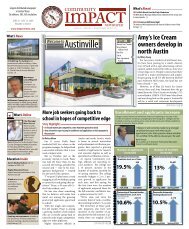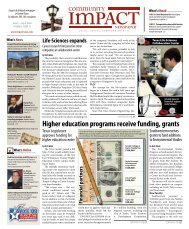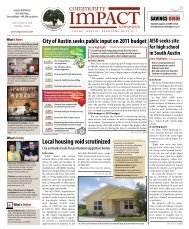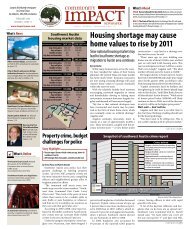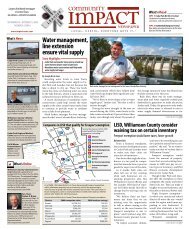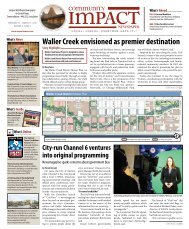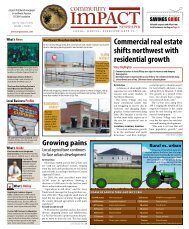Cedar Park & Leander - Community Impact Newspaper
Cedar Park & Leander - Community Impact Newspaper
Cedar Park & Leander - Community Impact Newspaper
You also want an ePaper? Increase the reach of your titles
YUMPU automatically turns print PDFs into web optimized ePapers that Google loves.
Photos by Jenn Rains<br />
<strong>Community</strong> Close-up | da Vinci Surgical System <strong>Cedar</strong> <strong>Park</strong><br />
By Jenn Rains<br />
In September 2009, <strong>Cedar</strong><br />
<strong>Park</strong> Regional Medical Center<br />
got a helping hand for<br />
surgeries—the da Vinci Surgical<br />
System. This $1.3 million system<br />
is a robotic-assisted technology<br />
that aids surgeons in performing<br />
complex procedures without<br />
using large incisions. The use of<br />
da Vinci helps reduce pain levels<br />
and recovery times for patients.<br />
Since the first operation<br />
using the technique on<br />
Clinic and Sleep Center<br />
Said Soubra, MD<br />
Harsh Babbar, MD<br />
Shantanu Naik, MD<br />
Oakmont Business <strong>Park</strong><br />
1464 East Whitestone Blvd.<br />
Building 6 • 512-986-7765<br />
<strong>Cedar</strong> <strong>Park</strong>, Texas 78613<br />
Oct. 15, 2009, CPRMC has had<br />
42 operations using the system,<br />
which allows the surgeon to use<br />
finger controls on a console to<br />
maneuver instruments on the<br />
surgical table while looking at a<br />
3-D image provided by a highdefinition<br />
camera.<br />
Dr. Carl Bischoff, a urologist<br />
at CPRMC, is just one of<br />
many doctors trained on the da<br />
Vinci Surgical System. Bischoff<br />
has used the da Vinci robot to<br />
remove cancer from kidneys,<br />
The main components of the da Vinci Surgical System include a set of robotic instrument arms at the operating table, a central<br />
computer system and a console, right, in which the surgeon performs the procedure and communicates with assistants.<br />
State of the art Sleep Center providing:<br />
• Comprehensive evaluation of all sleep disorders.<br />
• Initial Evaluation by Expert Sleep physicians,<br />
• Night time sleep studies (polysomnogram) and follow up.<br />
Building adjoins Pulmonary and Sleep clinic.<br />
Ellie Burke<br />
the bladder and prostate. He has<br />
also used the system to perform<br />
urinary and pelvic organ reconstructive<br />
surgery.<br />
“Historically, robotic surgery<br />
has mainly been used in<br />
the field of urology,” he said.<br />
“Recently, however, there has<br />
been adoption of this technology<br />
in other surgical disciplines<br />
as well. This is a very exciting<br />
time for robotic-assisted<br />
surgery.”<br />
Three instrument arms, left, contain surgical<br />
tools, including forceps, needle drivers,<br />
graspers, scissors and bisectors, that are<br />
switched out for each operation. The robotic<br />
arms replicate the surgeon’s movements in real<br />
time, and a high-definition camera with two<br />
lenses records the operation. The tools, above,<br />
are narrower than a fingertip, allowing them to<br />
enter the body through small incisions.<br />
<strong>Community</strong> <strong>Impact</strong> <strong>Newspaper</strong> • impactnews.com May 2010 | 23<br />
A technician who trains surgeons on the device demonstrates how the<br />
surgeon views the operation as a 3-D image within a scope, top, at the<br />
console. The surgeon controls the robotic instrument arms with a set<br />
of stabilized finger grips, center, allowing for smoother, more precise<br />
movements. The high-definition camera is adjusted with foot pedals.




